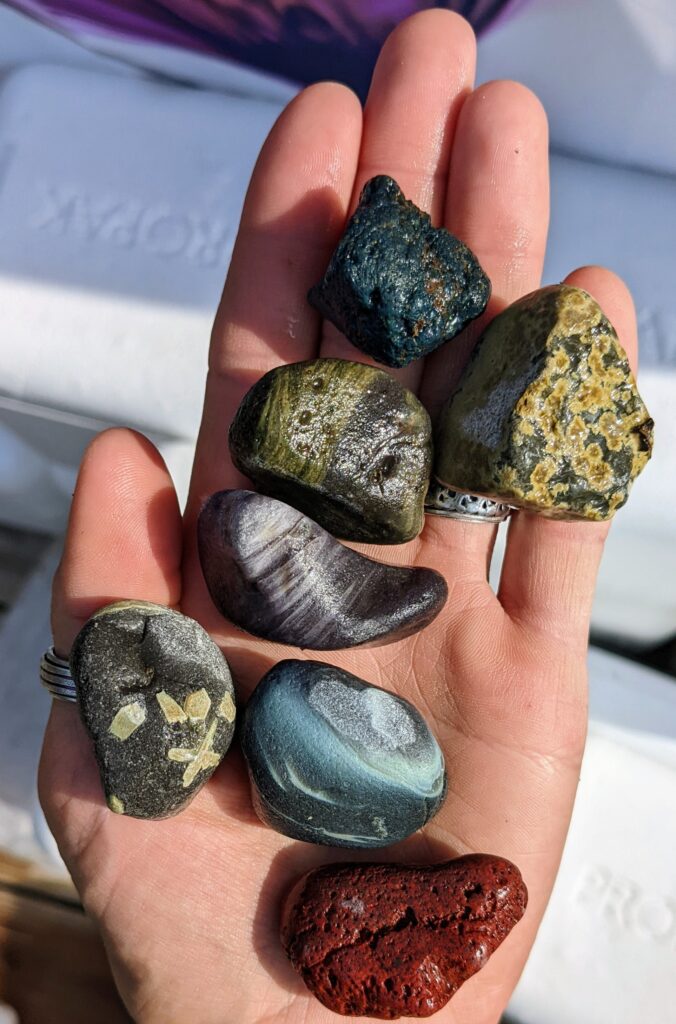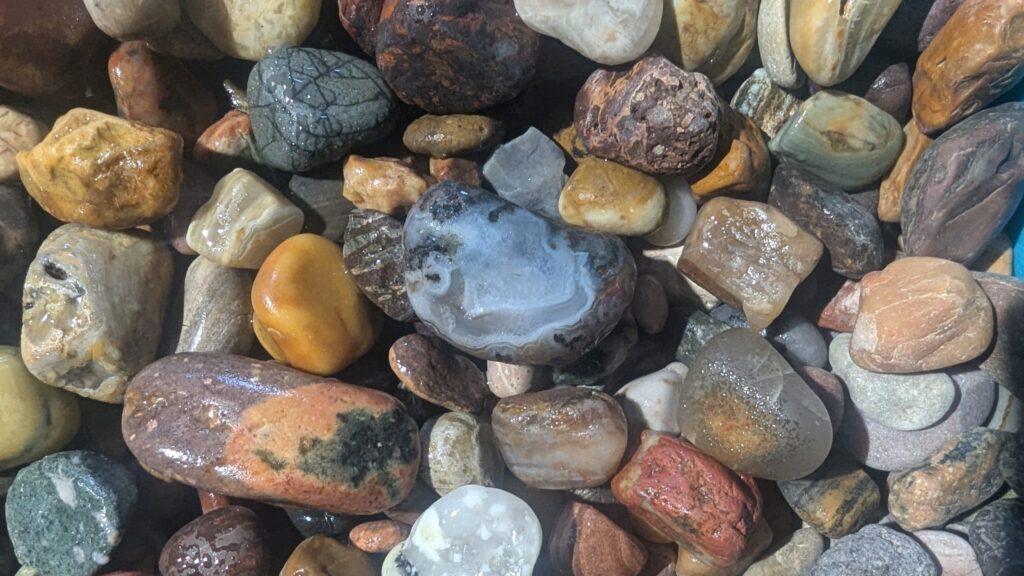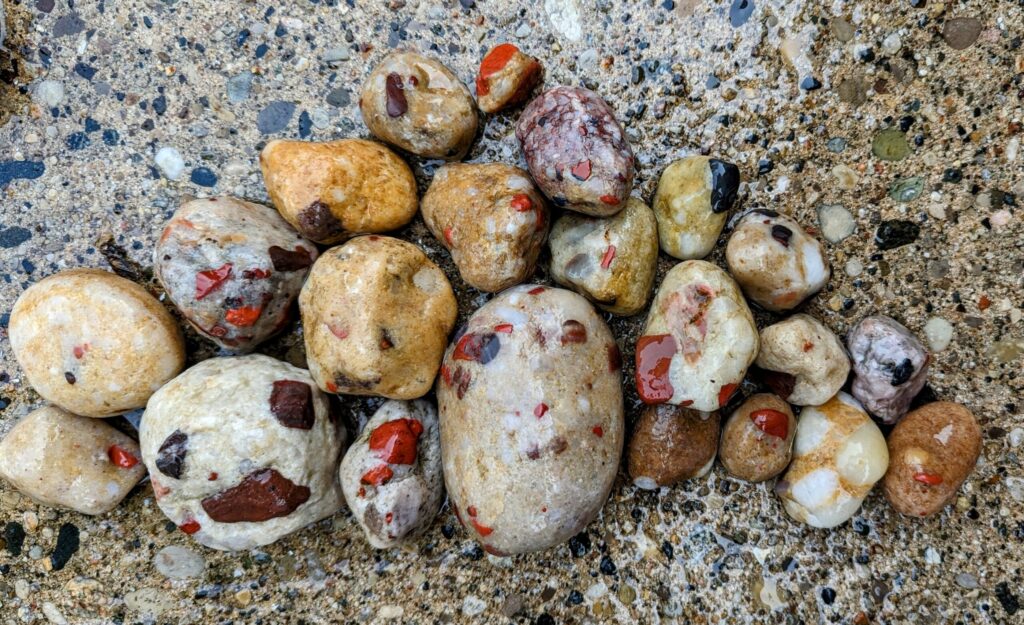Rockhounding in Michigan
Rules for rockhounding in Michigan
First and foremost, I want to say- Please do your own research and make sure you are following the laws of rockhounding in Michigan. Each state has different laws, so please do your research and as always- Pack in what you pack out and leave our public land better than how we found it. Take a small trash bag with you each time you go out, because sadly, rockhounding has become increasingly popular and I have seen so many of my favorite places filled with trash now and things ruined. Please be respectful.
Where is it ILLEGAL to take rocks in Michigan?
Within any National Park and National Lakeshore.
This includes:
- Isle Royale
- Pictured Rocks
- Porcupine Mountains
As well as any historical site in Michigan.
State Laws are as follows:
25lbs. (in total) PER PERSON, per year. This includes all types of rocks AND fossils. Slag and beach glass are manmade, so this rule does not apply to those.
There are no limits on how much you can collect from private land, given you have permission to from the owner of the land.
Federal Laws are as follows:
The annual limit for collecting USDA-administered National Forest and National Recreation lands is “a small reasonable amount for personal use.”
Some signs indicate this means about 10lbs.
Collecting invertebrate fossils is allowed on USDA lands.
Slag


Although slag is manmade and is considered a pollutant, I have found that hunting for these bright colored chunks are just as fun hunting for as rocks and beach glass.
These bright colored chunks derive from separation from iron ore during the smelting process, which creates a glassy bright colored looking stone. As slag was created in furnaces, it is often pitted with air bubbles created when the molten slag was cooling after being separated from the purified iron ore.
it can be found in at least 3 of our 5 Great Lakes. I know this because I’ve found it myself! I must say though, Lake Superior takes the cake on this one. I couldn’t believe how bright the colors were! If you’re knee deep on a calm sunny day, those bright blues will jump right out at you and it’s so fun to find!
The bright blues have been known to show up around the Leland area, but I have had much better luck in Lake superior finding bigger and brighter pieces. Perhaps that is due to the Leland shorelines being well picked over. Not every blue piece of slag is called Leland blue by the way. It is only called that when it is found in Leland. Every other blue piece of slag found outside of Leland is just called slag.
Agate


What defines an agate?
Agate is a banded, fibrous variety of chalcedony. Agate stones are characterized by alternating bands of different colored chalcedony. When held up to the sunlight, you should be able to see some light come through some parts of it. There are a lot of imposters out there that are pretty hard to tell apart until you learn how to spot the differences.
Where can they be found?
Agates can be found all over, although they are the prettiest coming from Lake Superior in my experience. I have found them from South Haven area all the way up to Munising. Inland and on the shorelines.
Petoskey stones & Puddingstones


What is a Petoskey stone?
It is actually a fossilized coral from the Devonian period which was around 350 million years ago!
Where can they be found?
Petoskey stones are most certainly found in more places than in Petoskey Michigan. I have found them all over Michigan including Lake Superior, South Haven and even inland. Although some may say if you find one in Lake Superior, then someone surely had brought it there from the Lower Peninsula.
I have had best of luck finding them are on dirt roads after rainfall all over Michigan. Hunting in lesser populated areas is always your best bet.
What is a puddingstone?
Puddingstones are a type of conglomerate that contain chunks of jasper and other small pieces that formed together.
Puddingstones are pretty spread out over the state as well. I don’t hunt for them because personally I think they’re quite ugly, but if I come across a decent one, I’ll take it home and make something with it.
Tips for getting started
If you are new to rockhounding and looking for some reliable information to help you along the way, these are things that have helped me tremendously. It takes quite some time to start learning how to identify what each rock is, but be patient and enjoy the hunting!
Books purchased through Amazon that I keep on hand at all times:
Michigan rocks & fossils field guide book from amazon
Can be purchased here: Michigan Rocks & Minerals: A Field Guide to the Great Lake State (Rocks & Minerals Identification Guides): Lynch, Dan R., Lynch, Bob: 9781591932390: Amazon.com: Books
Lake Superior rocks & minerals field guide
Can be purchased here: Lake Superior Rocks & Minerals Field Guide (Rocks & Minerals Identification Guides): Lynch, Dan R., Lynch, Bob: 9781647550585: Amazon.com: Books
Lake Superior agates field guide
Can be purchased here: Lake Superior Agates Field Guide (Rocks & Minerals Identification Guides): Lynch, Dan R., Lynch, Bob: 9781591932826: Amazon.com: Books
Agate hunting made easy
Can be purchased here: Agate Hunting Made Easy: How to Really Find Lake Superior Agates: Magnuson, Jim, Wood, Carol: 9781591933267: Amazon.com: Books
Petoskey Stone- Finding, Identifying and collecting
Can be purchased here: Petoskey Stone: Finding, Identifying, and Collecting Michigan’s Most Storied Fossil: Lynch, Dan R.: 9781591938415: Amazon.com: Books
Facebook groups that have helped tremendously:
facebook.com/michiganrockhounds
facebook.com/rockidentification
I also joined Indian Mounds Rock & mineral club which provided me with alot of information and was very helpful.
Disclaimer: These helpful bits of info are provided for informational purposes only. I am not affiliated with, sponsored by, or receiving any compensation from the company or product mentioned.
Chameleon Nature ©
